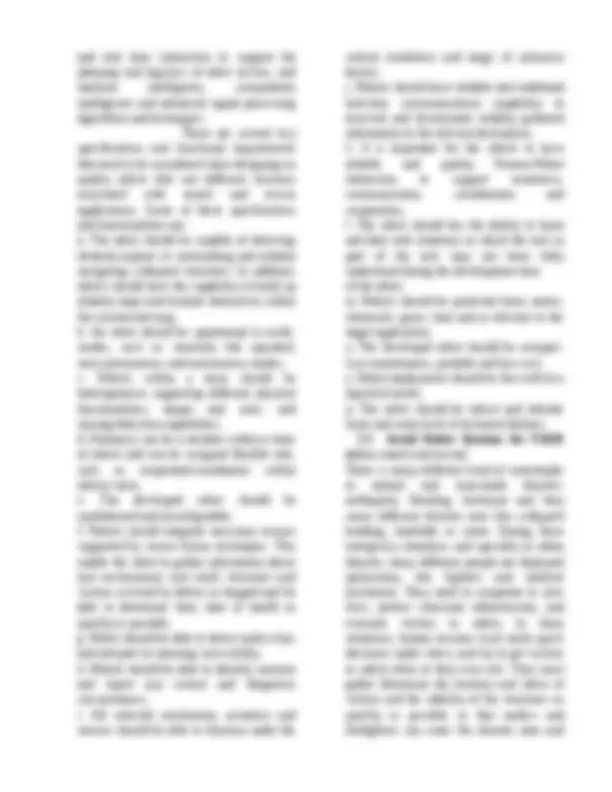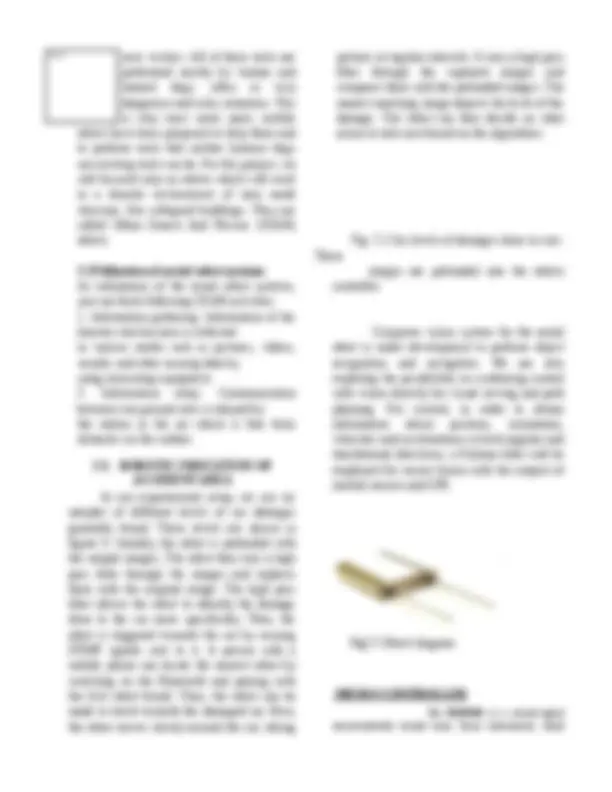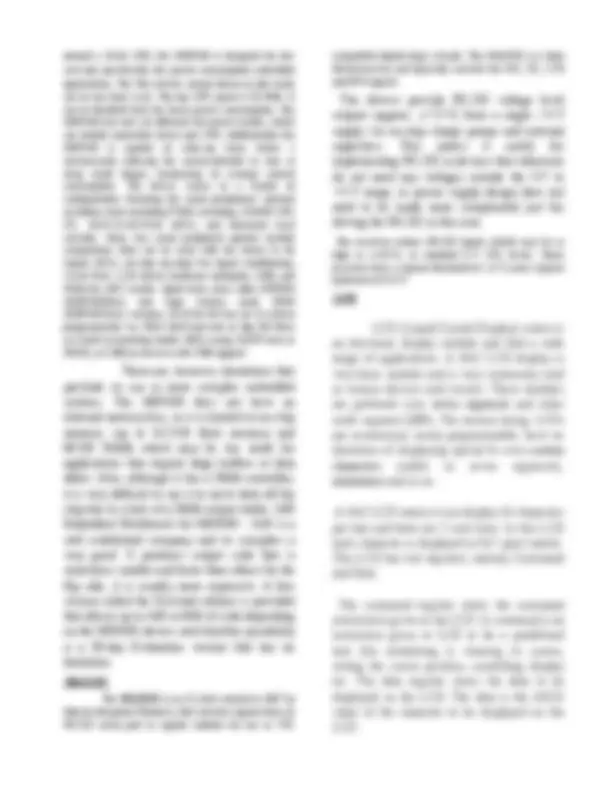





Study with the several resources on Docsity

Earn points by helping other students or get them with a premium plan


Prepare for your exams
Study with the several resources on Docsity

Earn points to download
Earn points by helping other students or get them with a premium plan
Community
Ask the community for help and clear up your study doubts
Discover the best universities in your country according to Docsity users
Free resources
Download our free guides on studying techniques, anxiety management strategies, and thesis advice from Docsity tutors
projct papr
Typology: Study notes
1 / 7

This page cannot be seen from the preview
Don't miss anything!




DEPT OF AE&I
ASIET, KALADY, ASIET, KALADY ASIET,KALADY
INDIA INDIA INDIA jiyajohnson10@gmail.com keerthana.menon659@gmail.com midhun.midhun.mohandas@gmail.com
Robotics can play an important ,intelligent and technical roles that support first response equipment in harsh and dangerous environments while replacing rescue personnel from entering unreachable or unsafe places. Solving and fulfilling the needs of such tasks presents challenges in robotic mechanical structure and mobility ,sensors and sensor fusion, autonomous and semi autonomous control ,planning and navigation, and machine intelligence. Unmanned Aerial photography (UAPs) are rapidly becoming a key technology in the military domain and offer great promises are a useful technology in many commercial and civil applications in future. Development of a suitable lightweight system in which a sensor is airborne for carrying out surveillance. The ir transmitter transmits the ir signals continuously to the maximum level of 3 ft. When the ir signals are reflected back by an object then the signals is
received by the ir receiver ,thus the module senses the obstacle. An embedded system has been developed which observes an a object, the system also send an alert message to the authorized user through gsm such that remedy measures could be easily taken
Index Terms —Flying robot, micro helicopter ,urban search and rescue.
Technology has become the solution to many long-standing problems, and while current technologies may be effective, it is far from fully addressing the hug, complex, difficult and challenging tasks associated with disaster missions and risky intervention. The challenge is in finding creative, reliable and applicable technical solutions in such highly constrained and uncertain environment. In addition, it is necessary to overcome constrains on resources by developing innovative, cost effective and practical technology.
Robotics can play important intelligent and technological roles that support first response equipment in harsh and dangerous environments while replacing rescue personnel from entering unreachable or unsafe places. Robotics solutions that are well adapted to local conditions of unstructured and unknown environment can greatly improve safety and security of personnel as well as work efficiency, productivity and flexibility. Solving and fulfilling the needs of such tasks presents challenges in robotic mechanical structure and mobility, sensors and sensor fusion, autonomous and semi autonomous control, planning and navigation, and machine intelligence. This paper categorizes the source of disasters and associated missions, and highlights the needs for suitable and reliable technology and technical and functional
requirements of robotic systems to fulfill task objectives. In addition, it shows that robotic technologies can be used for disasters prevention or early warning, intervention and recovery efforts during disasters with all possible kinds of relevant missions while ensuring quality of service and safety of human beings. Some of these missions may include: demining, search and rescue, surveillance, reconnaissance and risk assessment, evacuation assistance, intrusion/ victim detection.
2.THE FLYING ROBOT CONCEPT Robotics solutions that are well adapted to local conditions of unstructured and unknown environment can greatly improve safety and security of personnel as well as work efficiency, productivity and flexibility.Solving and fulfilling the needs of such tasks presents challenges in robotic mechanics and mobility, sensors and sensor fusion, autonomous or semi autonomous navigation and machine intelligence. Advancement in information and communication technologies along with remote sensing, satellite communication, GPS, and GIS technologies together with the Internet can help a great deal in planning and implementation of hazards reduction measures.
Fig1.1:Image taken by robot
A robot is usually an extremely flexible and complex machine, which integrates science and engineering. Each technology used in robotic systems has its own challenges to offer. The opportunity for robotics to help humanity arises when there are not enough skilled people available to do certain tasks at a reasonable price, like elder care. Much thought has been put into development of robotic helpers for the infants and elderly. Advances in microtechnology, microprocessors, sensor technology, smart materials, signal processing and computing technologies, information and communication technologies, navigation technology, and biological inspiration in learning and decision making capabilities have led to breakthrough in the invention of a new generation of robots called service robots. Service robot is a generic term covering all robots that are not intended for industrial use, i.e., perform services useful to the well being of humans, and other equipment (maintenance, repair, cleaning etc.), and are not intended for rationalizing production. It is clear that the development of a unique and universal robot that can operate under wide and different task and environmental conditions to meet requirements is not a simple task. Robotics research requires the successful integration of a number of disparate technologies that need to have a focus to develop: flexible mechanics and modular structures, mobility and behavior based control architecture, human support functionalities and interaction, homogeneous and heterogeneous sensors integration and data fusion, different aspect of fast autonomous or semi- autonomous navigation in a dynamic and unstructured environment, planning, coordination, and cooperation among multi robots, wireless connectivity and natural communication with humans, virtual reality
save victims. All of these tasks are performed mostly by human and trained dogs, often in very dangerous and risky situations. This is why since some years, mobile robots have been proposed to help them and to perform tasks that neither humans dogs nor existing tools can do. For this project, we will focused only on robots which will work in a disaster environment of man made structure, like collapsed buildings. They are called Urban Search And Rescue (USAR) robots.
2.2Utilization of aerial robot systems As utilizations of the aerial robot systems, you can think following USAR activities.
2.3. ROBOTIC INDICATION OF ACCIDENT AREA In our experimental setup, we use six samples of different levels of car damages generally found. These levels are shown in figure 3. Initially, the robot is preloaded with the sample images. The robot then runs a high pass filter through the images and replaces them with the original image. The high pass filter allows the robot to identify the damage done to the car more specifically. Then, the robot is triggered towards the car by sensing DTMF signals sent to it. A person with a mobile phone can locate the nearest robot by switching on the Bluetooth and pairing with the first robot found. Then, the robot can be made to travel towards the damaged car. Now, the robot moves slowly around the car, taking
pictures at regular intervals. It runs a high pass filter through the captured images and compares them with the preloaded images. The nearest matching image depicts the level of the damage. The robot can then decide on what action to take next based on the algorithms.
Fig. 2.1.Six levels of damages done to cars. These images are preloaded into the robots controller.
Computer vision system for the aerial robot is under development to perform object recognition and navigation. We are also exploring the possibilities in combining control with vision directly for visual serving and path planning. For control, in order to obtain information about position, orientation, velocities and accelerations in both angular and translational directions, a Kalman filter will be employed for sensor fusion with the outputs of inertial sensors and GPS.
Fig2.2:Block diagram
The MSP430 is a mixed-signal microcontroller family from Texas Instruments. Built
CameraCrystal
around a 16-bit CPU, the MSP430 is designed for low cost and, specifically, low power consumption embedded applications. The The electric current drawn in idle mode can be less than 1 μA. The top CPU speed is 25 MHz. It can be throttled back for lower power consumption. The MSP430 also uses six different low-power modes, which can disable unneeded clocks and CPU. Additionally, the MSP430 is capable of wake-up times below 1 microsecond, allowing the microcontroller to stay in sleep mode longer, minimizing its average current consumption. The device comes in a variety of configurations featuring the usual peripherals: internal oscillator, timer including PWM, watchdog, USART, SPI, I²C, 10/12/14/16/24-bit ADCs, and brownout reset circuitry. Some less usual peripheral options include comparators (that can be used with the timers to do simple ADC), on-chip op-amps for signal conditioning, 12-bit DAC, LCD driver, hardware multiplier, USB, and DMA for ADC results. Apart from some older EPROM (MSP430E3xx) and high volume mask ROM (MSP430Cxxx) versions, all of the devices are in-system programmable via JTAG (full four-wire or Spy-Bi-Wire) or a built in bootstrap loader (BSL) using UART such as RS232, or USB on devices with USB support.
There are, however, limitations that preclude its use in more complex embedded systems. The MSP430 does not have an external memory bus, so it is limited to on-chip memory (up to 512 KB flash memory and 66 KB RAM) which may be too small for applications that require large buffers or data tables. Also, although it has a DMA controller, it is very difficult to use it to move data off the chip due to a lack of a DMA output strobe. IAR Embedded Workbench for MSP430 - IAR is a well established company and its compiler is very good. It produces output code that is sometimes smaller and faster than others.On the flip side, it is usually more expensive. A free version called the Kickstart edition is provided that allows up to 4kB or 8kB of code depending on the MSP430 device used.Another possibility is a 30-day Evaluation version that has no limitation.
MAX 232 The MAX232 is an IC, first created in 1987 by Maxim Integrated Products, that converts signals from an RS-232 serial port to signals suitable for use in TTL
compatible digital logic circuits. The MAX232 is a dual driver/receiver and typically converts the RX, TX, CTS and RTS signals. The drivers provide RS-232 voltage level outputs (approx. ± 7.5 V) from a single + 5 V supply via on-chip charge pumps and external capacitors. This makes it useful for implementing RS-232 in devices that otherwise do not need any voltages outside the 0 V to
LCD (Liquid Crystal Display) screen is an electronic display module and find a wide range of applications. A 16x2 LCD display is very basic module and is very commonly used in various devices and circuits. These modules are preferred over seven segments and other multi segment LEDs. The reasons being: LCDs are economical; easily programmable; have no limitation of displaying special & even custom characters (unlike in seven segments), animations and so on.
A 16x2 LCD means it can display 16 characters per line and there are 2 such lines. In this LCD each character is displayed in 5x7 pixel matrix. This LCD has two registers, namely, Command and Data.
The command register stores the command instructions given to the LCD. A command is an instruction given to LCD to do a predefined task like initializing it, clearing its screen, setting the cursor position, controlling display etc. The data register stores the data to be displayed on the LCD. The data is the ASCII value of the character to be displayed on the LCD.
[3] E. Sahin, T.H. Labella, V. Trianni, J. L. Deneubourg, P. Rasse, D. Floreano, L. Gambardella, F. Mondada, S. Nolfi, and M. Dorigo. SWARM-BOTS: Pattern formation in a swarm of self